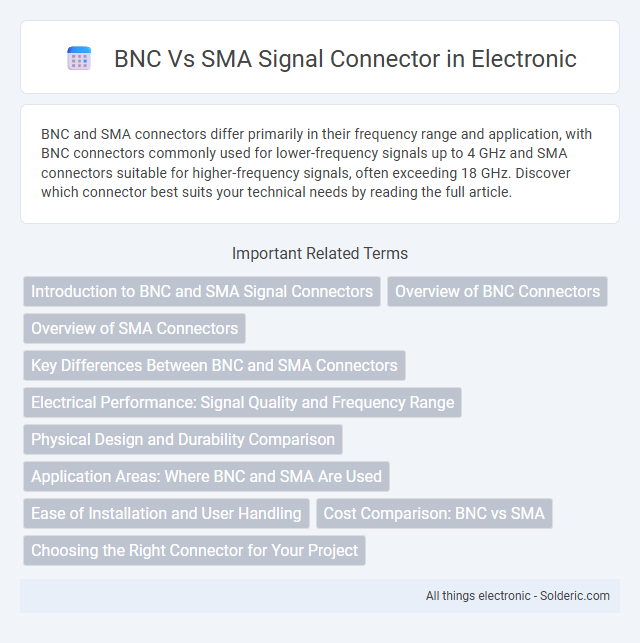BNC and SMA connectors differ primarily in their frequency range and application, with BNC connectors commonly used for lower-frequency signals up to 4 GHz and SMA connectors suitable for higher-frequency signals, often exceeding 18 GHz. Discover which connector best suits your technical needs by reading the full article.
Comparison Table
| Feature | BNC Connector | SMA Connector |
|---|---|---|
| Type | Bayonet Neill-Concelman | SubMiniature version A |
| Frequency Range | Up to 4 GHz | Up to 18 GHz (some types up to 26.5 GHz) |
| Impedance | 50 O or 75 O | 50 O |
| Size | Larger, bulkier | Compact, smaller |
| Coupling Mechanism | Bayonet locking | Screw type threaded |
| Durability | Medium mechanical life (~500 cycles) | High mechanical life (~500+ cycles) |
| Applications | Radio, Video, Test equipment | RF, Microwave, High-frequency measurements |
| Connector Cost | Low to moderate | Moderate to high |
Introduction to BNC and SMA Signal Connectors
BNC and SMA signal connectors serve distinct purposes in electronic and RF applications, with BNC connectors commonly used for quick connect/disconnect in low to medium frequency signals up to 4 GHz. SMA connectors provide high precision and superior performance for microwave frequencies up to 18 GHz, featuring screw-type coupling to ensure secure connections. Understanding the frequency range and mechanical design of these connectors helps you select the right component for your specific signal transmission needs.
Overview of BNC Connectors
BNC connectors, widely used for RF signal transmission, provide reliable and quick connect/disconnect capabilities in audio, video, and networking applications. Designed with a bayonet locking mechanism, they ensure secure connections suitable for frequencies up to 4 GHz and 75 ohms impedance. Their compact size and robust construction make BNC connectors ideal for professional environments requiring stable analog and digital signal integrity.
Overview of SMA Connectors
SMA connectors are precision coaxial RF connectors designed for high-frequency applications up to 18 GHz and beyond, offering superior performance in signal integrity and low insertion loss compared to BNC connectors. Their threaded coupling mechanism ensures a secure and stable connection, making them ideal for use in telecommunications, aerospace, and microwave systems. SMA connectors provide consistent impedance control at 50 ohms, critical for minimizing signal reflections in sensitive RF measurements.
Key Differences Between BNC and SMA Connectors
BNC connectors feature bayonet locking mechanisms and are commonly used in video and RF applications up to 4 GHz, while SMA connectors use threaded coupling for higher frequency performance, supporting up to 18 GHz or more. BNC connectors offer ease of connection and disconnection, ideal for test equipment and low-frequency setups, whereas SMA connectors provide superior signal integrity and minimal insertion loss for precision RF systems. Size and durability differ, with SMA connectors being smaller and more robust, suited for compact, high-frequency applications requiring stable and reliable connections.
Electrical Performance: Signal Quality and Frequency Range
BNC connectors provide stable electrical performance with a frequency range typically up to 4 GHz, making them ideal for standard RF applications requiring moderate signal integrity. SMA connectors excel in maintaining superior signal quality and can operate at significantly higher frequencies, often up to 18 GHz or more, supporting precision applications with stringent electrical performance demands. Your choice between BNC and SMA should consider the required frequency range and signal quality to ensure optimal connectivity in your system.
Physical Design and Durability Comparison
BNC connectors feature a bayonet locking mechanism with a larger, cylindrical body typically measuring 21mm in diameter, offering robust physical design suited for frequent connections and disconnections in broadcast and test equipment. SMA connectors are smaller, with a 6.35mm hexagonal body and threaded coupling, providing superior durability in high-frequency applications up to 18 GHz, ensuring stable, vibration-resistant connections. The rugged metal construction of both connectors enhances longevity, but SMA's precision threading generally results in better mechanical stability under harsh environmental conditions.
Application Areas: Where BNC and SMA Are Used
BNC connectors are widely used in video transmission, radio frequency (RF) applications, and test equipment due to their quick connect/disconnect design and reliability at frequencies up to 4 GHz. SMA connectors excel in high-frequency applications such as microwave systems, antennas, and cellular communication, supporting frequencies up to 18 GHz and offering superior performance in environments requiring compact and durable connections. You should choose BNC connectors for lower-frequency, general-purpose signal transmission, while SMA connectors are ideal for precision, high-frequency RF applications.
Ease of Installation and User Handling
BNC connectors offer straightforward twist-lock installation, enabling secure connections with minimal effort, making them ideal for quick setups and frequent reconnections. SMA connectors require precise threading and torque application, providing robust, vibration-resistant connections but demanding more skill and time during installation. User handling favors BNC for simplicity and speed, while SMA excels in durability and performance in high-frequency applications.
Cost Comparison: BNC vs SMA
BNC connectors generally offer a lower cost compared to SMA connectors due to their simpler design and widespread use in lower-frequency applications. SMA connectors, designed for high-frequency and precision RF connections, tend to be more expensive because of their precise manufacturing tolerances and superior performance. Choosing between BNC and SMA connectors often depends on balancing cost requirements with the necessary frequency range and signal integrity.
Choosing the Right Connector for Your Project
Selecting between BNC and SMA connectors depends on frequency requirements and application type. BNC connectors excel in applications up to 4 GHz, offering quick connect/disconnect features ideal for test equipment and low-frequency signals. SMA connectors support frequencies up to 18 GHz or higher, making them suitable for high-frequency RF systems requiring compact, reliable connections.
BNC vs SMA signal connector Infographic

 solderic.com
solderic.com